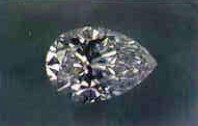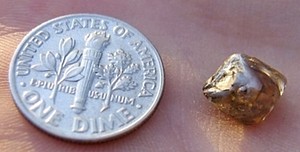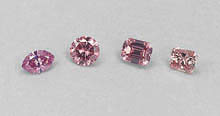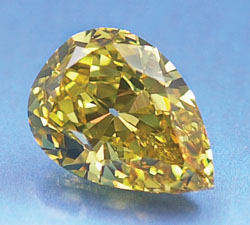DIAMOND - The Hardest Gem
Diamond is the most important of all gemstones. It is easily the best known of all gems, having a long and colorful history throughout the civilized world. Because of its great hardness, for many centuries, diamonds were considered nearly impossible to polish. Even its name derives from the Greek word adamas, which means “invincible”. Only after much experimentation were the techniques necessary to polish a diamond developed. For many years this secret was kept among a limited few individuals.
Even comparatively small diamonds with good quality have significant value. Its value derives from three important properties: its hardness; its brilliancy which results from its high index of refraction; and his fire which results from its strong dispersion. Because of its value and durability, the purchase of diamond jewelry has become associated with weddings, anniversaries, and other major milestones.
When making an important diamond purchase, many individuals are confused by the apparent wide range of prices for what seem to be similar stones. The prices of diamond gems are greatly affected by the quality of the stone. It is entirely possible to purchase a one carat loose diamond gem for less than $1000. The quality of such a gem of course, is nothing less than awful. It will have many large visible inclusions, and be badly off-color - perhaps with visible cracks as well. On the other hand, a fine quality diamond of a full carat size may well be priced in excess of $15,000. This huge difference in price between the two is due to the difference in quality.


Understanding The Four C's of buying a Diamond
In order to help the diamond buying public better understand the quality of diamonds and how they are priced, jewelers developed to four C grading system. This system has been taught to the diamond buying consumer for decades. The four C's on which diamonds are rated are the following: Carat weight, color, clarity, and cut.
Carat weight – The carat weight is the size of the stone.
Prices are commonly giver per carat, even when the
stones are less than one carat. Prices per carat increase as the stones become larger, as
larger stones are rarer. There is a significant price increase at round number carat
breaks – so stone of 0.99 carats is notably less costly than a stone of 1.01 carats,
even though the buyer may no be able to see the difference.
Diamond color – The preferred color is white and any
increase in coloration results in a less valuable stone. Common pale colors found in
diamonds include yellows, browns and grays. Good values can sometimes be found in near
white stones that appear white to the eye, but under careful scrutiny are actually very
pale colored. Stones with deep color are called fancy colored stones and are more valuable
than pale colored stones that are not white or near white. Such light colored stones,
mostly from Australia, have been promoted in recent years as “champagne” colored
diamonds.
Diamond clarity – Any flaws within the stone greatly detract
from the value. Flaws run the full range from tiny white specs that cannot be seen without
magnification, to large black inclusions that severely mar the appearance of the gem. Most
diamonds have at least slight inclusions, and better prices can usually be obtained on
stones with slight inclusions, but are still so small that they cannot be seen without
magnification to assist the human eye.
Cut and Polish – A diamond needs to be properly cut and
polished to show its maximum brilliance and fire. Stones that are cut too deeply or too
shallow do not reflect the full amount of sparkle and brilliance. Improper polish also
reduces brilliance.
Purchasing Diamond Jewelry
Because most diamond purchases are
significant expenditures and made in relation to some sort of special occasion, it is
worth doing a bit a research to determine what you want and to get the best prices.
Diamonds are a significant purchase, so whether its for your engagement ring, diamond stud
earrings, tennis bracelets or other special jewelry, make sure the diamond jewelry you buy
is jewelry you like and will enjoy. It is better to save and make the purchase you will
enjoy than to rush and regretting the hurried pace.
Diamonds come from a wide variety of
sources across the planet. The principal producers are in Africa, Australia and Russia.
While the De Beers diamond cartel only mines a part of the earth’s diamonds, they
still have a strong hand in the distribution of a large percentage of the world’s
production. They also still exert a significant effect on diamond prices. Recent events
have raised concerns about the origin of diamonds and the use of diamonds to fund war and
terrorism. While only a small fraction of the world’s diamonds are mined in areas
where conflict and terrorism are issues, there is still concern over what are termed
“conflict diamonds” or “blood diamonds”. Leading diamond marketers
have developed a system to guarantee that their diamonds were not involved in the conflict
and war process.
Coming soon is more detailed information on
diamonds – all you ever wanted to know! I will be featuring separate pages on:
On Diamonds:
Diamond Colors; Diamond Clarity; Diamond Cut and Polish; Diamond Carat Weight; Diamond Prices and Markups; Diamond Grading and Laboratory Reports; Conflict Diamonds;
Diamond Mine sources Worldwide; Canadian
Diamonds; Australian Diamonds; Champagne Diamonds;
Fancy Colored Diamonds; Care of
Diamond Jewelry; Rough Diamond Crystals; Diamond as a Mineral; Synthetic and simulated diamonds; How the diamond
trade works; Diamond Treatments and alterations
On Diamond Jewelry:
Purchasing that meaningful piece of jewelry (don’t rush); Diamond Rings;
Engagement Rings; Colored
Stone and Diamond Engagement Rings; Diamond
Earrings; Diamond Tennis bracelets; Diamond Pendants; Designing your own Custom
Diamond Jewelry


